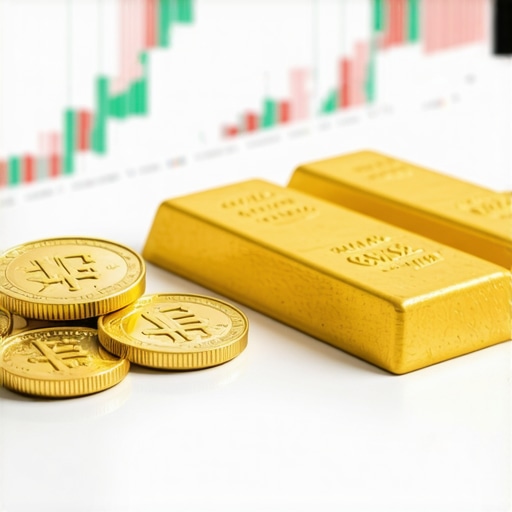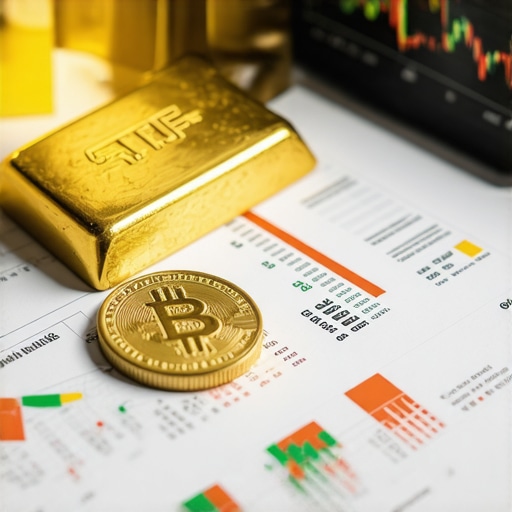Unlocking the Nuanced Realm of Gold Investment Strategies for 2024
In an era marked by economic flux and geopolitical uncertainties, gold remains an indispensable asset class for sophisticated investors aiming to diversify and hedge against systemic risks. As we venture into 2024, understanding the complex landscape of gold investments—including physical coins and bars, exchange-traded funds (ETFs), and stocks—becomes paramount for crafting resilient portfolios rooted in expert insight.
The Intricacies of Physical Gold: Coins and Bars as Tangible Wealth
Physical gold, encompassing coins and bars, offers unparalleled security and liquidity, especially when stored in high-grade vaults or secure safes. Coins such as American Eagles or Canadian Maple Leafs embody numismatic value alongside intrinsic worth, making them appealing for both collectors and investors. Bars, often produced by reputable mints or refineries, provide cost-effective exposure to gold’s price movements, especially when purchased in large quantities. Yet, the challenge lies in navigating premium costs, authenticity verification, and storage solutions—factors that significantly influence net returns. Exploring trusted dealer networks and secure storage options is vital; see this guide on trusted gold dealers for expert strategies.
Gold ETFs and Stocks: Navigating the Liquidity and Diversification Dimensions
Gold ETFs, like SPDR Gold Shares (GLD), enable investors to gain exposure without the logistical burdens of physical storage, offering high liquidity and ease of trading. Conversely, gold mining stocks provide leveraged exposure to gold’s price dynamics, coupled with the potential for dividend income and growth opportunities. The choice between ETFs and stocks hinges on risk appetite, investment horizon, and market outlook. For a deep dive into market drivers, consult this comprehensive gold market analysis.
Expert Query: How Do Central Bank Policies Shape Gold Investment Strategies in 2024?
Central banks play a pivotal role in influencing gold prices through their monetary policies and reserve management. Their accumulation or liquidation of gold reserves signals market sentiment, impacting investor confidence. In 2024, shifts in policies by major economies, especially regarding inflation targeting and currency stabilization, necessitate vigilant monitoring. This dynamic underscores the importance of integrating macroeconomic analysis into gold investment decisions, see this source on central bank actions.
Why is the diversification of gold investment types crucial for long-term wealth preservation?
Expert investors recognize that a balanced approach—combining physical assets, ETFs, and stocks—mitigates risks associated with market volatility, storage costs, and liquidity constraints. Diversification ensures resilience against localized disruptions, geopolitical shocks, and regulatory changes, fostering a robust, adaptable portfolio.
As the landscape evolves, aligning your strategy with emerging trends and authoritative insights ensures optimal positioning. For more advanced strategies, explore top gold investment strategies for 2025.
Interested in sharing your expert insights or learning from industry leaders? Engage with our community or consult specialized resources to refine your gold investment approach.
Exploring Sophisticated Gold Investment Tactics for 2024
As gold continues to serve as a cornerstone of diversified portfolios amid volatile markets, understanding advanced strategies becomes crucial for seasoned investors. Moving beyond traditional holdings, integrating derivative instruments such as gold options and futures can amplify gains or hedge risks more effectively. These instruments require nuanced knowledge of market timing, volatility forecasting, and risk management—skills that are refined through rigorous analysis and strategic planning. For example, mastering gold futures trading techniques can provide leverage while managing exposure, especially during turbulent economic phases.
The Power of Macro and Microeconomic Analysis in Gold Investment
Strategic investors leverage macroeconomic indicators—such as inflation rates, currency fluctuations, and geopolitical developments—to forecast gold price trajectories. Microeconomic factors, including sector-specific demand (jewelry, technology, industry) and mine output, also influence supply-demand dynamics. Integrating these layers of analysis enables a more precise prediction of short- and long-term movements. For instance, monitoring key market drivers like central bank policies or technological advances helps determine optimal entry and exit points. Employing advanced tools, such as economic dashboards and predictive models, enhances decision-making precision.
Challenging Assumptions: Is Gold Still the Ultimate Safe Haven in 2024?
While gold has traditionally been viewed as a safe haven, recent market shifts prompt a reassessment of this assumption. Factors such as rising technological integration in gold use and shifts in investor sentiment may alter its role. Experts argue that diversification across different gold investment types—physical, ETFs, stocks—serves as a hedge against paradigm shifts. A comprehensive approach, combining these assets with other commodities or alternative investments, reduces overreliance on gold alone. To refine your strategy, consult this resource on demand trends which emphasizes the importance of understanding evolving industrial and consumer needs.
Are you leveraging the latest tools and insights to optimize your gold investment portfolio in 2024?
Engaging with expert analysis, continuously updating your knowledge base, and employing innovative trading strategies can significantly enhance your outcomes. For in-depth guidance, explore top strategies to maximize gold returns. Additionally, sharing your experiences or seeking peer insights can provide practical perspectives for refining your approach.
Harnessing the Power of Geopolitical Shifts to Optimize Gold Portfolios in 2024
In the rapidly evolving landscape of global politics, geopolitical tensions remain a paramount factor influencing gold prices. From trade disputes to regional conflicts, these events induce market volatility, often driving investors toward safe-haven assets like gold. Experts emphasize the importance of incorporating geopolitical risk assessments into your investment thesis, utilizing real-time news analytics, and geopolitical risk indices such as the Geopolitical Risk Index (GPR) to refine timing and allocation strategies. Staying ahead of geopolitical developments can enable investors to capitalize on short-term price surges or hedge against potential downturns, thus adding a layer of strategic depth to your portfolio management.
Deciphering the Role of Technological Innovation in Gold Demand and Supply Dynamics
Technological advancements are reshaping both the demand and extraction of gold. Innovations in electronics, renewable energy, and digital currencies are expanding industrial and consumer use cases. Notably, the rise of blockchain technology and cryptocurrencies has sparked debate about gold’s role as a digital asset hedge. According to a 2023 report by the World Gold Council, increased industrial demand, coupled with innovations in gold recycling and mining automation, profoundly influences supply-side factors. Investors should monitor technological trends and R&D investments, as these can signal shifts in gold’s supply elasticity and long-term price stability.
Expert-Level Question: How Can Artificial Intelligence Enhance Gold Market Forecasting?
Artificial intelligence (AI) and machine learning models offer unprecedented capabilities for analyzing vast datasets, uncovering hidden patterns, and predicting market movements with higher accuracy. AI-driven algorithms can integrate macroeconomic indicators, sentiment analysis from news sources, social media trends, and technical chart patterns to generate nuanced forecasts. A notable application is the use of neural networks to model gold’s response to complex variables such as currency fluctuations, interest rates, and geopolitical events. According to a 2024 study published in the Journal of Financial Data Science, AI-based models outperform traditional statistical methods in predicting short-term price volatility, providing traders and portfolio managers with a competitive edge. Incorporating AI tools into your research process can significantly refine entry and exit strategies, especially during turbulent periods.
Strategic Action: Leveraging Deep Data Analytics for Portfolio Optimization
Deep data analytics involves harnessing big data to identify micro-trends within the gold market, such as regional demand shifts, mining supply disruptions, or regulatory changes. Advanced analytics platforms can process satellite imagery to monitor mine activity, analyze shipping and trade data for supply chain insights, and evaluate sentiment across global markets. For instance, integrating data from the Satellite Data Analytics Firm allows investors to detect early signs of supply constraints, while social media sentiment analysis can gauge investor psychology. These insights enable proactive adjustments to your gold holdings, ensuring resilience against unforeseen shocks and optimizing risk-adjusted returns.
Is Gold Still a Safe Haven or Evolving into a Dynamic Asset Class in 2024?
While gold’s reputation as a safe haven endures, the asset’s role is increasingly complex. The integration of gold into digital portfolios, its industrial demand, and emerging regulatory frameworks suggest a broader, more dynamic profile. Experts advocate for a layered approach—diversifying across physical gold, ETFs, stocks, and derivatives—to adapt to shifting market paradigms. As the landscape matures, continuous education in derivatives trading, macroeconomic analysis, and technological tools is essential for staying competitive. For a comprehensive understanding, explore this detailed guide on modern gold investing.
Are you utilizing the latest analytical tools and real-time data streams to refine your gold strategy in 2024?
Engagement with cutting-edge analytics platforms, AI models, and geopolitical risk assessments can significantly enhance decision-making. To deepen your expertise, consider subscribing to specialized financial data services and participating in expert webinars. Share your insights and learn from industry leaders to stay ahead in this dynamic environment. For ongoing updates and advanced strategies, visit Gold Investing Hub.
Harnessing Quantum Computing to Predict Gold Market Movements in 2024
Emerging technologies such as quantum computing are beginning to revolutionize financial modeling, enabling analysts to process complex market data at unprecedented speeds. By leveraging quantum algorithms, investors can simulate numerous economic scenarios, identify subtle market signals, and refine their predictions of gold price fluctuations with higher accuracy. According to a recent report by the Quantum Finance Journal, integration of quantum computing in asset pricing models can significantly enhance portfolio optimization strategies, especially amid volatile macroeconomic conditions. Embracing this frontier can provide a critical edge in crafting resilient, data-driven investment plans for 2024.
Expert Insights & Advanced Considerations
1. Technological Evolution’s Impact on Gold Valuation
Emerging innovations like blockchain integration and automation in mining are transforming supply chains and industrial demand, necessitating investors to monitor technological R&D investments and industrial applications to anticipate long-term price shifts.
2. Macro-Financial Indicators as Predictive Tools
Inflation trends, currency stability, and geopolitical tensions serve as vital indicators for gold’s trajectory, emphasizing the importance of integrating macroeconomic analytics with market sentiment to inform timely investment decisions.
3. Diversification Across Gold-Related Assets
Balancing physical gold, ETFs, and mining stocks enhances resilience, offering protection against volatility and regulatory shifts, and aligning with sophisticated portfolio management strategies.
4. Leveraging AI and Data Analytics
Adopting artificial intelligence and big data tools enables deep market insights, improving predictive accuracy and optimizing entry and exit points amid market turbulence.
5. Incorporating Geopolitical Risk Assessments
Utilizing real-time risk indices and news analytics helps investors capitalize on market volatility driven by geopolitical developments, maintaining a strategic edge in portfolio management.
Curated Expert Resources
- World Gold Council: An authoritative source on industrial demand trends, technological impacts, and long-term supply forecasts.
- Geopolitical Risk Index (GPR): A vital tool for assessing geopolitical tensions affecting gold prices and market stability.
- Financial Data Science Journals: Publications featuring AI and machine learning applications in market forecasting, crucial for adopting advanced analytical techniques.
- Official Central Bank Reports: Essential for understanding monetary policy shifts and reserve management affecting gold valuation.
- Satellitedata.com: Cutting-edge analytics for real-time supply chain monitoring, offering micro-level insights for proactive investment adjustments.
Final Expert Perspective
In 2024, mastering gold investment demands a sophisticated blend of macroeconomic analysis, technological awareness, and advanced data-driven strategies. The evolving landscape underscores the importance of integrating AI, geopolitical risk assessment, and diversification to optimize portfolio resilience. Staying ahead requires continuous education and engagement with authoritative resources—be it through industry reports, technological insights, or real-time analytics—to craft resilient, informed investment strategies. We invite you to deepen your expertise by exploring these resources and sharing your insights with the professional community, ensuring your approach remains agile and well-informed in this dynamic environment.










